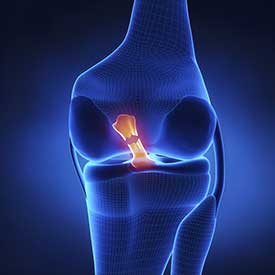ACL Tear Treatment in Kingston, NH

An ACL tear is a relatively common injury that affects the knee. This injury is characterized by the tearing of the anterior cruciate ligament (ACL), an important stabilizing structure of the knee. The ACL is one of two ligaments in the center of the knee that connect the femur to the tibia. The ACL originates in a large notch at the end of the femur and runs diagonally to insert on the top surface of the tibia.
Injuries to the ACL range from mild - or a partial tear - to severe, like when the ligament tears completely. Partial ACL tears are not as common as complete or near complete ACL tears. ACL tears and partial ACL tears occur when a person straightens his or her knee beyond its normal limits, twists it or bends it side to side. About half of all ACL injuries cause additional damage to other structures of the knee, like the meniscus.
ACL Injuries: Causes and Symptoms
Anterior cruciate ligament tears are more likely to occur if you play high-impact sports where rapid movement is common. Contact from physical activities, a sudden and severe accident, or less obvious contact injuries are also common causes of ACL injuries. However, if you are inactive or have weak leg muscles, it is possible to injure or tear the ACL during normal activities.
Immediately following the injury, it's common to experience pain and swelling, and your knee may feel unstable. Within a few hours of an ACL tear, you may experience a diminished range of motion and radiating pain or tenderness while walking. Other common symptoms of ACL injuries include:
- Feeling or hearing a popping noise in the knee at the time of the injury
- Pain on the outside and back of the knee
- Swelling
- The knee buckling or giving out
Diagnosing ACL Injuries
There are several ways to diagnose an ACL injury. Your doctor will start by gathering a thorough history of how the injury occurred, but a physical exam is often the most reliable diagnostic tool. During the physical exam, your physician will assess the knee's laxity compared to the uninjured knee using various tests. An ACL injury is typically graded on the amount of the ligament that tears and, therefore, the severity of the injury. ACL tears are categorized in the following ways:
- Grade I: Minor trauma or sprain to the ligament. Some ligament fibers are stretched, but none are torn.
- Grade II: More severe trauma or a partial tear of the ligament. In some cases, the ligament is stretched to the point where it becomes loose.
- Grade III: Severe trauma to the ligament where the ACL is torn completely.
Depending on the severity of the injury, your doctor may order imaging tests to help confirm the diagnosis. Magnetic resonance imaging (MRI) is the most effective way to diagnose an ACL injury because it gives your doctor the ability to view high-quality images of the ligaments, tendons, muscles and cartilage around the ACL.
Treatment of an ACL Tear
Treatment for an ACL injury varies depending on the patient's needs. Some people are able to continue normal activities with an ACL injury, and others require surgery. Surgery is a better option if you want to fully restore ACL function and return to a high level of activity. Nonsurgical methods are effective in relieving pain and minimizing symptoms, but the ACL cannot heal completely without surgery. The most common nonsurgical treatments include physical therapy and bracing.
In a majority of cases, the ACL cannot be sutured back together, and it may require a soft tissue graft to reconstruct the ligament. A surgeon commonly takes grafts from the patellar tendon, hamstring tendon or quadriceps tendon. Knee arthroscopy is a procedure that physicians use to diagnose and treat joint problems. During an arthroscopic surgical procedure, a tiny camera is inserted into the knee through small incisions. The surgeon will use the camera to check the ligaments and other knee tissues to assess the damage. He or she will then fix the damaged areas and replace the ACL with the graft.
Physicians often perform arthroscopic surgery on an outpatient basis. Following arthroscopic surgery, you may experience swelling, and there may be some numbness around the treatment area. Many patients apply ice to get relief from any swelling or soreness. Many side effects from the surgery will dissipate within a couple days. Physical therapy goes hand-in-hand with arthroscopic surgery to strengthen the grafted material. Most people are able to return to regular activity within four to six months, although each patient reacts differently to treatment.
Request more information about ACL tear treatment today. Call (207) 536-9661 or contact Vibrant Health Naturopathic Medical Center online.
Vibrant Health Naturopathic Medical Center
Address
3 Riverside DriveGreenland, NH 03840
(207) 536-9661
www.vibranthealthnaturalmedicine.com
Hours
Mon:
8:30 am - 5:00 pm
Tue:
9:00 am - 5:00 pm
Wed:
10:30 am - 5:00 pm
Thu:
9:00 am - 5:00 pm
Fri:
10:00 am - 4:00 pm
Sat:
Closed
Sun:
Closed

